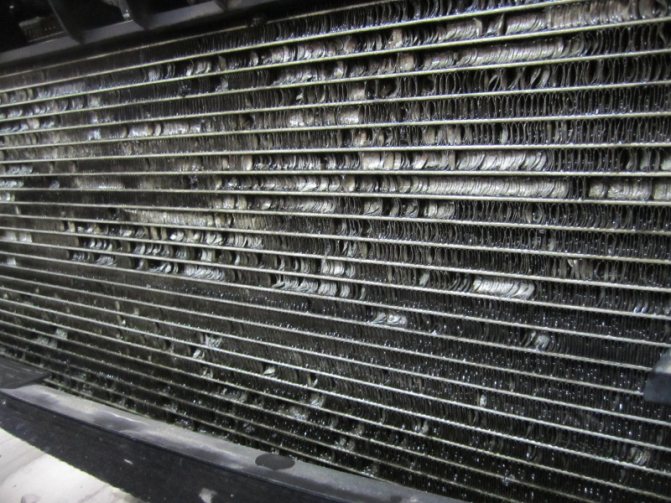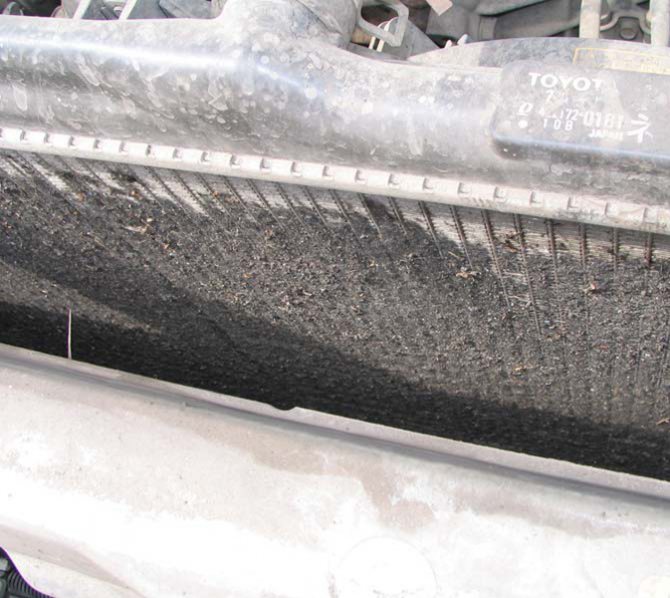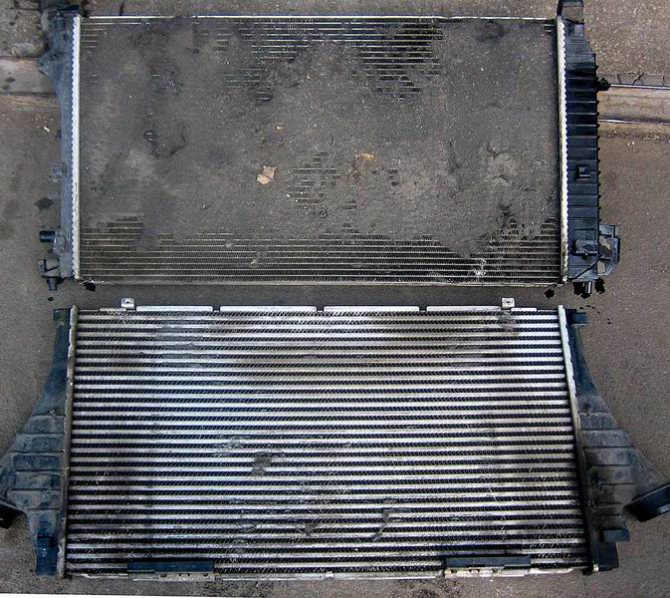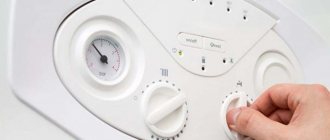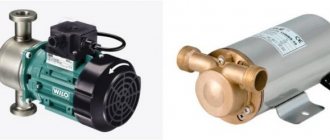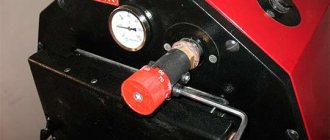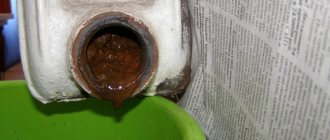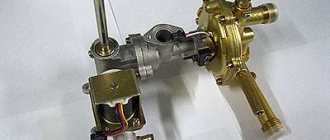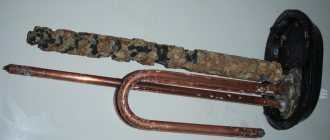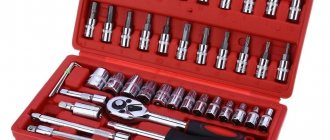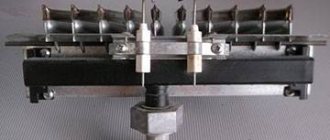Almost every motorist at least once in his driving life has come across such a phenomenon as engine overheating. For some, this is a rarity, while for others it is a daily routine.

Overheating should not be underestimated, since it can lead to rather serious negative consequences, which will manifest itself in the form of costly breakdowns. And sometimes the situation turns out to be completely critical when the engine fails, major repairs are required, or a complete replacement of the power unit.
In order to prevent such a development of the scenario, you should periodically check the state of the cooling system, monitor its performance and promptly perform all actions aimed at eliminating malfunctions.
But some problems appear unexpectedly, and sometimes it is difficult to prevent or foresee them. Therefore, motorists and even experienced car owners need to understand why the radiator remains cold, and the car heats up, that is, the internal combustion engine temperature rises.
Symptoms and Causes
To understand the question of why the radiator remains cold, and the engine is hot at the same time, one should study the signs and directly the reasons for such a situation.
The main symptom is a rise in temperature on the gauge, which is located directly on the dashboard of your car. The arrow goes beyond the white zone and turns into the red one. On other machines, slightly different controllers are used, therefore, a warning light on the instrument panel may simply light up, indicating an excessively high temperature, perceived as overheating.
Other signs are a drop in engine power, loss of traction, and knocking knocks when the driver abruptly presses the accelerator pedal and accelerates. The reason for the detonation is that the increased temperature has led to a change in the combustion process of the air-fuel mixture inside the working cylinders. Instead of burning the mixture, it starts to explode. The combustion process is replaced by explosions.
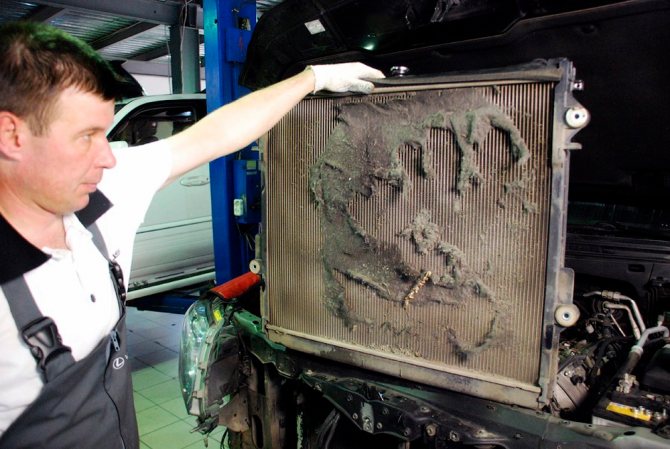

Do not forget about the existing engine temperature standards. In normal working condition, the motor warms up to 85-95 degrees Celsius. This is not considered overheating, but is positioned as the optimal operating mode of the internal combustion engine. Situations are allowed when temperature indicators increase to 100-105 degrees Celsius. Especially in situations where we are talking about a short-term promotion. This is a common situation in the summer, when a prolonged downtime in a cork contributes to heating slightly higher than the intended performance.
In fact, heating up to 105 degrees Celsius can be taken as normal. But if the temperature rises, overcoming the maximum permissible limits, here we are talking about overheating. It is necessary to look for objective reasons why this is happening, as well as find a way out of this situation.
Experts identify several reasons why the engine overheats, and the radiator of the cooling system itself is cold:
- Lack of coolant in the system. The most commonplace reason that you should pay attention to in the first place. If there is not enough cooling liquid, it will boil earlier, which will provoke system malfunctions. The process of heat removal is disrupted;
- Violation of tightness. Do not forget that the cooling system is not airtight. Gradually, some of the coolant leaves and evaporates. Therefore, it is important to control its level and periodically add antifreeze;
- Leaks in the radiator, pipes and fittings;
- Internal leaks arising from cracks in the cylinder head or BC, as well as due to punched gaskets. As a result, antifreeze penetrates the cylinders;
- Radiator. He uses a small honeycomb that can easily get dirty. As a result, the normal circulation of the coolant is disrupted due to accumulated deposits. If the cooling fan turns on, but the radiator remains cold, the circulation of antifreeze is probably disturbed;
- Sensor. In many vehicles, the radiator fan is activated by a command from a monitoring sensor. If this sensor does not transmit a signal, the fan will not work, or it will not function efficiently enough;
- Air congestion. Another reason why the engine is almost boiling is that the radiator remains cold. In parallel with this, the temperature sensor does not always indicate that there is overheating in the system. Electronics does not notice how the internal combustion engine is boiling. It is required to get rid of the airlock;
- Thermostat. The engine may warm up, but the radiator is still cold at times due to the fact that the thermostat is out of order. This is a special valve that distributes the coolant flows in two circles. The small circle provides circulation inside the cooling jacket, which is required for quick warm-up. A large circle runs through the radiator to provide more efficient cooling. If the thermostat sticks, the antifreeze will only be able to pass in a small circle, that is, the radiator will remain cold and the engine will boil. As a result, the motor heats up, and our radiator is invariably cold. Here it is worth touching the lower pipes that go to the radiator. If they are cold and the engine overheats, the thermostat is probably the problem;
- Pump malfunction. The cooling system uses a pump, that is, a water pump that pumps antifreeze. This allows you to create a forced circulation system. Typically, the pump is leaking or the impeller elements are worn out. Jamming can sometimes occur. If the radiator is cold and the motor overheats, but there are no signs of leakage, then the reason lies in the worn impeller. That is, the pump does not pump antifreeze well, the liquid in the motor, moving in a small circle, heats up more intensely than in the radiator. As a result, it turns out that the heating is uneven, the engine is already boiling, and the radiator is still cold.
As you can clearly see, there are many reasons for this condition of the engine and radiator of the cooling system. And each of them can potentially lead to serious consequences.
Additional reasons
It is clearly seen that there are quite a number of reasons for overheating of the power plant on a car with an absolutely cold cooling radiator.
Regardless of the reasons, any excessive overheating of the motor when the temperature rises to critical levels is a harbinger of serious breakdowns and malfunctions. It is much easier and cheaper to prevent them than to eliminate them later.
It is also interesting that there are situations when there are no contaminants in the cooling system, antifreeze or antifreeze is at a sufficient level, the water pump, fan and thermostat are in good working order, work well. But with all this, the engine continues to overheat. If the situation develops in this way, it is strongly recommended to check the ignition timing. If it is knocked down, then the combustion process of the air-fuel mixture will be disrupted, the engine will start to overheat.
Causes of malfunction
The most likely reason why the refrigerator compressor is heating up may be:
- burnt out or "stuck" start-up relay;
- uninterrupted operation in fast freezing mode;
- violation of the tightness of the refrigerating or freezing chambers;
- freon leak;
- clogging of capillary channels;
- software failures in the control module.
A damaged rubber seal causes the door to not fit tightly, warm air enters the working chamber, and the motor has to forcefully pump refrigerant.
Freon leakage can occur due to mechanical damage to the circulation channels. This usually happens due to attempts to scrape off ice from the walls of the freezer or unsuccessful transportation. In this case, sealing of the damaged channels and refueling of freon is required.
Sudden power surges lead to malfunctions of the Control Unit, its configuration and settings. In some cases, overvoltage provokes burnout of electronic components. The problem is solved by reprogramming the module or completely replacing the board. Frequent power outages and power surges are a fairly common situation in our time. Therefore, in order to avoid such troubles, you need to take care of high-quality stabilizers and surge protectors in advance.
If you notice that the refrigerator motor has become too hot, disconnect it from the power supply and call a repair technician. Only a technician will be able to determine the exact cause of the breakdown that led to overheating of the compressor.
Correct driver action
In situations where the engine overheats, but the radiator remains cold, it is important to take the right measures to prevent the situation from getting worse, and also try to prevent any serious malfunctions and costly breakdowns.
Sometimes it happens that the driver panics ahead of time. This usually happens among motorists who have only recently got behind the wheel, or have changed the car, not yet having time to get used to the peculiarities of its behavior and to the operating modes of the engine itself.
Here we are talking about short-term overheating, which can, to a certain extent, be considered the norm for many motors. Short-term overheating usually occurs during prolonged idle time in a traffic jam. Then the arrow of the temperature sensor, displayed on the dashboard, rises to the critical red zone. But as soon as the car starts to move, when there is airflow due to oncoming air flows, and the cooling fan is activated, the temperature returns to normal. That is, to begin with, try to observe and monitor whether the temperature will drop after the jump up, to the red zone.
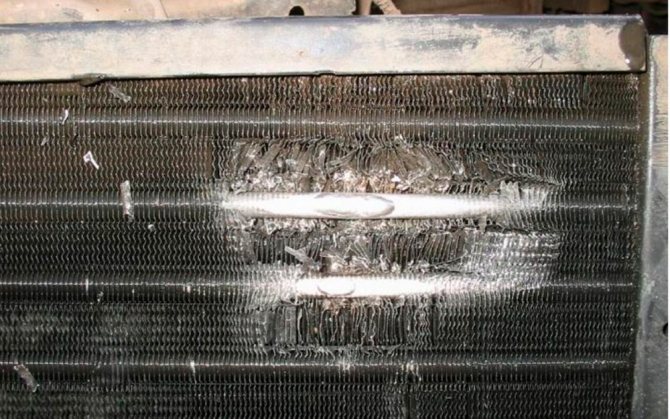

But do not wait and watch when the car was in motion, that is, there was blowing with oncoming air, or the fan was working. In such situations, experts give several useful recommendations:
- If the car was moving in completely normal conditions that do not provoke short-term overheating, but the temperature still starts to increase and reaches a critical level, do not turn off the engine immediately;
- Also, do not try to cool the power unit by pouring cold water on it outside, or by adding cold water to the expansion tank with cooling liquid;
- If you ignore these recommendations, fill the engine with water or add it to the reservoir, you will probably have to repair the engine. Moreover, such repairs are often accompanied by the obligatory replacement of the cylinder block and the head of the block;
- If you want to cool the engine, lower the engine temperature with a cold radiator to normal levels, it is better to leave the road, stop and turn on the stove in the car. It doesn't matter if it is spring or summer, the cabin is warm enough without a working heating;
- Turning on the stove will allow you to remove excess heat from the engine, transferring it to the interior of your car;
- In parallel, the engine itself must not be turned off. Simply put the gearbox in neutral and leave the engine idling;
- Wait a few minutes after completing all the described steps;
- In parallel, check for signs of coolant leakage anywhere. To do this, you have to get out of the car, look under the car and into the engine compartment;
- If there are no leaks, then the manipulations carried out with the stove and the idle speed of the power unit did not allow the temperature to drop below the critical mark, turn off the engine.
Next, you will need to call a tow truck or ask someone to be towed to get to the garage or the nearest service center. There you will already find out the reasons, look for the culprit and carry out the appropriate repair and restoration work.
But there are situations when the engine needs to be turned off as soon as the engine temperature has reached its peak value. These are the cases when, while driving, you suddenly saw steam from under the engine compartment, and at the same time there are traces of coolant leakage. If you are faced with similar circumstances, stop and turn off the engine. There is no need to wait until the temperature starts to drop after turning on the stove. Otherwise, you risk completely ditching the engine.
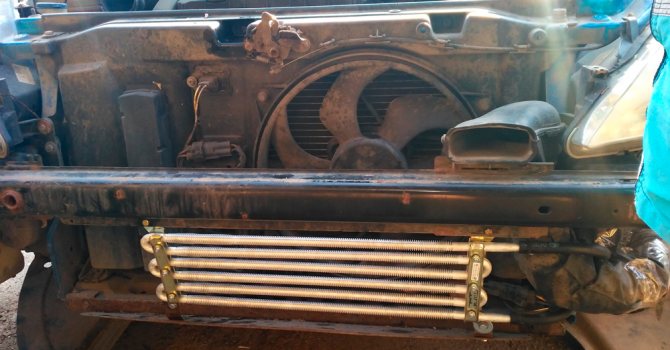

The engine needs proper operation. This is the basis for its safety, effective, safe and long-term work. Also, in parallel, always try to monitor the condition of the cooling system. Any traces of coolant leakage, a small coolant level in the expansion tank, an excessive rise in temperature under normal operating conditions should be a reason to check the condition of the entire system.
When faced with a situation where the power plant on your car is noticeably overheating, take appropriate action, find the cause of the rise in temperature and eliminate it. If difficulties arise with self-diagnosis, it is better to immediately seek help from qualified specialists.


The problem of engine overheating is well known to the vast majority of drivers. In this case, overheating of the engine can lead to serious damage or complete failure of the internal combustion engine. To prevent this from happening, the engine cooling system needs periodic maintenance and constant performance monitoring.
In this case, a number of malfunctions can still occur unexpectedly. This means that it is very important to know why the engine heats up in certain cases. In this article, we will talk about common causes of overheating, what to do if the engine is boiling, but the radiator is cold, etc.
Read in this article
Engine overheating: main symptoms and causes
Let's start with the signs. First of all, this is the engine temperature gauge on the dashboard in the red zone. Also, on some models, a warning light may simply light up, indicating overheating.
Another sign of engine overheating is a decrease in engine power, loss of traction and knocking knocks when you press the gas pedal sharply or just when accelerating. The reason is that the process of fuel combustion in the cylinders is disrupted from an increase in temperature (explosions of the working mixture instead of combustion).
However, if the heating of the motor is above 105 degrees, then this is already overheating and you need to look for reasons. The simplest and most understandable is the low level of coolant in the cooling system. We also add that the liquid in the engine boils at a low level, since the contact surface of the liquid and the heated motor is insufficient, that is, heat dissipation is impaired.
- It should also be borne in mind that the cooling system is not completely sealed and closed. During operation, the liquid evaporates, which causes a decrease in the level.
Where to look for the cause of engine overheating
Some motorists find that the engine is hot but cannot find signs of the problem. The question immediately comes to mind: “What to check and change first of all? ". In my opinion, first of all, you need to check the engine for a breakthrough of exhaust gases.
Through a hole or crack in the head or cylinder block, a punctured head gasket may also be the cause. At the same time, you can immediately conduct a test for the operation of the radiator and expansion tank cap. This test is described below.
old and new thermostats; check for a burst of exhaust gases
If the car is over ten years old, the thermostat must be replaced. In the event that the operation of the thermostat really raises suspicions, there is no need to sin on the pump at all.
We change it, if it doesn't help, then you need to remove the pump and check it already. When the result is unchanged, then you need flush the cooling system... Verification of other details requires a deeper clarification.
What to do if the engine overheats
First of all, it should be remembered that if the overheating is short-term (for example, the temperature arrow rises in a traffic jam), then you should observe whether the temperature will drop after the start of the movement (counter-air blowing appears) or as a result of turning on the radiator fan.
If the car was already in motion and the engine temperature reached a critical level, you should not turn off the engine immediately. Also, do not try to cool the engine by pouring water on it from the outside, pouring cold water into the radiator, etc. Such actions will lead to the need to repair the internal combustion engine, and it may be necessary to change the BC and cylinder head.
Next, you need to wait a few minutes, while examining whether there are obvious and strong signs of antifreeze / antifreeze leakage under the car or in the engine compartment. If no leaks are visible, but the temperature does not drop either, the unit must be damped.
Please note that it is necessary to turn off the engine immediately when steam has gone out from under the hood, traces of intense coolant leakage are clearly visible. In this case, the motor must be stopped, without expecting that turning on the stove will lower the heating.
Using your laptop on an uneven surface
Air vents on modern laptops are located not only on the side, but also on the bottom. A supply fan is located behind the side ventilation grill, which ensures the flow of cold air into the device case. It cools down the components that generate heat during operation. Heated air exits through the bottom vents.
The operating rules do not recommend using the devices on uneven surfaces. If the laptop is working on a rug or in a bed, the bottom vents are blocked and hot air cannot escape freely. As a result, the computer heats up, the system crashes, leading to slowdowns or regular reboots.


Note! Using your laptop on a level surface not only improves ventilation, but also reduces contamination.
Let's summarize
As you can see, there are a lot of reasons for engine overheating, and the very excess of the operating temperature has a very detrimental effect on the state of the internal combustion engine. In this case, it so happens that the cooling system is clean, the level of antifreeze is normal, the fan, pump and thermostat are working normally, but the motor still overheats. In this case, UOZ may be the culprit, since the process of fuel combustion when the ignition angle is knocked down is disrupted.
In some cases, the cause of overheating is the general wear of the motor and its CPG. Simply put, the piston rings wear out, and insufficient sealing of the combustion chamber leads not only to disruptions in the combustion process of the fuel charge, but also to the breakthrough of hot gases. In this situation, the motor power drops and overheating may occur.
Also, prolonged and heavy load on the engine sometimes leads to overheating. For example, wedged brake pads can impede rolling, as a result of which the driver actively loads the motor.If you add to this the car air conditioner turned on in the heat, the engine will be even more loaded.
How to understand that the engine has started to overheat: obvious and hidden signs of engine overheating. Common causes of overheating.
The engine temperature arrow jumps or jumps randomly: the main causes of this malfunction. Diagnosing problems with your own hands, recommendations.
Why does the engine overheat occur? What to expect for the driver and what damage can occur if the engine is overheated. What to do if the internal combustion engine overheats.
What is the temperature of the coolant (antifreeze, antifreeze) is normal on a warm engine. What affects the boiling point and other properties of the coolant.
The engine temperature does not rise, the ICE temperature arrow drops on the fly. Why does the temperature drop after turning on the stove. Diagnostics and repair, advice.
The engine does not reach operating temperature, the motor temperature arrow does not rise during warming up or falls during driving: causes of the malfunction.
A cold lower radiator pipe after heating the engine VAZ 2110, 2114, 2115 indicates a violation in the vehicle cooling system. If correct operation is not restored, the engine will overheat and result in engine failure. There are several reasons for the malfunctioning of the cooling system of a VAZ 2114, 2115, 2110 car. And even experienced motorists cannot always figure out why the lower pipe of the car's radiator remains cold.
Smartphone operating temperature range
According to official Apple information, all existing iPhones are designed to operate in ambient temperatures from 0 ° C to + 35 ° C. This means that it is the air temperature around the device that gives an idea of the numbers that you should pay attention to when viewing the weather forecast.
In Russia, the temperature outside in summer rarely heats up above + 35 ° C, but in winter it regularly drops below zero. In the central part of the country -50 as the norm.
In any case, a few extra degrees above 35 ° C for a short time should not cause problems in the smartphone. But if you go on vacation to warm countries, then you have to be more careful with the iPhone. In the same Dubai (United Arab Emirates), which is popular with tourists, the air temperature rarely drops below +40 ° C in summer.
Interesting fact: operating the phone at a very low temperature leads to an accelerated discharge of the battery - as a result, the iPhone turns off, but the battery does not suffer. Operating at very high temperatures, however, can permanently reduce battery life.
The above values are for iPhone use. The safe storage range is –20 to +45 ° C.
The device of the cooling system VAZ 2110
The main function of the cooling system is to maintain the engine operating temperature of 98-103 ° C. When the motor is running, the heat of the working parts is removed with the help of a coolant that is constantly circulating in the system. While the engine heats up, antifreeze or antifreeze moves in a small circle without passing through the radiator. The thermostat is closed at this time.
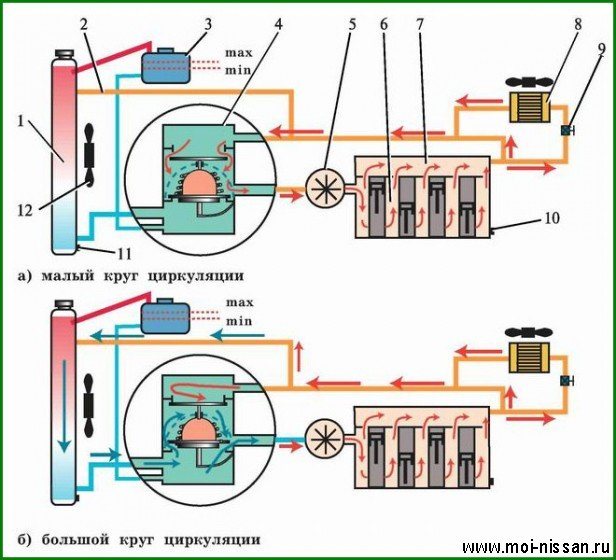

When the operating temperature is reached, the thermostat opens and the liquid circulates in a large circle. Both pipes become hot. The radiator contributes to more cooling by the air flow. The fan increases the cooling intensity. The pump provides continuous circulation. The thermostat regulates the amount of liquid supplied to the system.
Why the engine does not warm up to operating temperature
If the car engine does not warm up to 90 degrees during operation, it is necessary to urgently check its cooling system, most often the problem is associated with it. The following malfunctions can be distinguished that can lead to such problems:
Incorrect thermostat operation.In a car engine, a thermostat is responsible for switching the direction of movement of the coolant. When the engine is just starting, the coolant in it moves in a small circle, warming up the engine to operating temperature. When the engine temperature reaches about 90 degrees, the thermostat switches the direction of the coolant flows to a large circle. If the thermostat gets stuck and does not fulfill its direct responsibility to change the direction of movement of the coolant, this can lead to both overheating and hypothermia of the engine. Accordingly, you need to check the thermostat, and if it is faulty, you will need to replace it with a new one;
Above are the three most common reasons why the engine does not warm up to operating temperature (or the driver thinks that the engine is not warm enough). In 95% of cases, the problem is related to the thermostat, which is recommended to be changed every 3 years or every 50 thousand kilometers.
Causes of poor coolant circulation
According to the above diagram, the reason that the lower radiator pipe in the VAZ 2110, 2114, 2115 remains cold is the lack of fluid circulation in the large circle of the system. Note that the radiator is the main cooling element. Therefore, the upper branch pipe, through which the liquid enters the heat exchanger, will be hotter than the lower one, and with proper liquid circulation.


Possible causes of stagnation in the cooling system:
- clogged radiator;
- inoperative thermostat;
- airlock;
- breakdown of the pump.
Any intervention in the engine cooling system requires subsequent flushing of the SOD and replacement of the coolant. Poor quality coolant does not cope with cooling the motor and can cause blockage in the system.
Removing the airlock
Signs of the formation of an air lock in the cooling system are the rapid warming up of the car to high temperatures and poor performance of the cabin stove. This can be seen especially easily in winter. The reasons for the appearance of an airlock are different:
- incorrect filling of coolant;
- overheating of the engine;
- depressurization of the system;
- damage to some parts, etc.
If, during the check, antifreeze (antifreeze) leakage is found in the system, traces of coolant on the engine or other places, the causes of the leak should be eliminated. Depressurization often occurs due to poor tightening of the clamps on the pipes and hoses. They need to be tightened. Any deformed or defective parts found should be replaced.
There are several ways to remove air pockets. The easiest is to drive up a steep hill with your face up. Unscrew the radiator and expansion tank caps. Let the car warm up for 10-15 minutes. Then turn off gas a little and fill the system with coolant to the required level. Continue until bubbles stop appearing.
In VAZ 2110, 2114, 2115 cars, airing is rare. Clogged hoses or a clogged radiator can cause similar symptoms.
Cleaning or replacing the radiator
The radiator, located at the front of the vehicle, absorbs the main stream of dust and dirt. For its efficient operation, timely prevention and cleaning is required. The radiator can become dirty both inside and outside.
An indicator of internal cleanliness is the condition of the coolant. Manufacturers recommend changing the antifreeze every 75,000 km or every 5 years. However, a change in the color of the liquid, severe darkening, discoloration, the presence of rust requires an urgent replacement of the coolant. Antifreeze is recommended to be changed at least every 40,000 km.
To carry out the internal cleaning of the cooling system of the VAZ 2110, 2114, 2115, it is necessary to drain the liquid. Sequencing:
- open the cover of the expansion tank;
- substitute a container for draining antifreeze;
- unscrew the drain plug from the cylinder block;
- drain the refrigerant;
- unscrew the radiator drain plug (located at the lowest point);
- drain the remnants of antifreeze (antifreeze);
- tighten all plugs.
For cleaning, distilled water is poured into the system and the engine is started for about 20 minutes. Ordinary water contains many impurities and forms scale, so its use is undesirable. The liquid is drained several times until clear water flows. This method is ineffective as it removes a small amount of deposits.
For more effective washing, it is advisable to use special chemical additives. The detergent components that make up their composition allow you to dissolve deposits and remove various types of dirt. The vinegar / water mixture used by many motorists is less effective. It does not remove all deposits. After using chemistry, the cooling system is flushed with distillate.
After cleaning the entire VAZ 2110, 2114, 2115 cleaning system, an internal flushing of the radiator is additionally carried out. To do this, you need to detach the hoses from the base and upper and upper tank. Liquid is poured into the radiator through the top pipe using a garden hose. Flushing is carried out until clean water flows from the lower branch pipe.
The removed radiator can be cleaned externally to remove dirt, insects, sand from the cooler honeycomb. Cleaning is carried out with soapy water or special devices that create a strong flow of water or air, such as a Karcher vacuum cleaner. The procedure should be carried out carefully so as not to bend the radiator honeycomb.
If damaged or heavily soiled, the radiator should be replaced.
Replacing the thermostat
If the thermostat valve does not work properly, the coolant does not circulate in a large circle of SOD. At the same time, the lower branch pipe remains cold even after the refrigerant is heated to 90 ° C. The top pipe can be hot due to the escape of steam. The thermostat can jam in the open position, in which case the engine does not warm up to the desired temperature or heats up for too long.
In preparation for replacing the device, the system must be drained and the air filter removed. Then, the radiator and fluid pump hoses are disconnected from the thermostat housing. After that, loosen the mounting bolts and remove the thermostat cover. The device is changed to a serviceable one. The thermostat is attached in the reverse order.
These are the main reasons for the malfunctioning of the cooling system and the cold lower pipe of VAZ 2110, 2114, 2115 cars.

